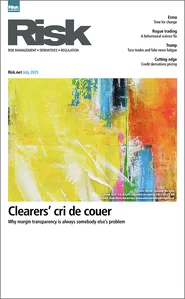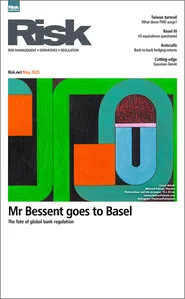Risk magazine - Volume22/No6
Articles in this issue
Value added
Valuation remains a major focus for banks and regulators. In this Class Notes article, Charles Smithson examines the academic approaches to valuation and applies them to structured credit assets
Sell suits
A number of lawsuits have emerged across the globe, with disgruntled corporates alleging they were sold unsuitable derivatives products and were unaware of the risks involved. Will changes to bank selling practices emerge as a result? By Christopher…
Permission to fail
Richard Baker, head of the Managed Funds Association, the Washington, DC-based industry body, talks to Alexander Campbell
Markets are not magic
Despite their pervasive contributions to economic growth and efficiency, it is important to remember markets are not magic when transparency fails, argues David Rowe
A return to credibility
The financial crisis has exposed the fact that many banks merely paid lip service to risk management, as well as relying too heavily on quantitative techniques. However, genuine risk management requires judgement and a strong risk culture within a firm,…
Getting the cycle to work
Regulators are keen for banks to take a through-the-cycle approach, as opposed to point-in-time, when calculating bank capital. But how are banks responding to the change? By Duncan Wood
Less than zero
A drop in inflation expectations last year sent dealers scrambling to hedge their exposures to 0% floors embedded in structured products, causing a massive dislocation in the inflation swaps market. Have dealers now covered their exposures? By Alexander…
A dynamic model for hard-to-borrow stocks
Traders with short positions in stocks that are subject to short-selling restrictions risk being 'bought in', in the sense that their positions may be closed out by the clearing firm at market prices. Marco Avellaneda and Mike Lipkin present a model for…
Inflation modelling with SABR dynamics
Fabio Mercurio and Nicola Moreni introduce a new forward Consumer Price Index model that is based on a multi-factor volatility structure and leads to SABR-like dynamics for forward inflation rates. Their approach reconciles zero-coupon and year-on-year…
The shock of the interaction
Banks have long talked of enterprise risk management, but many firms have historically measured risk types separately and aggregated the results. The financial crisis has highlighted that credit and market risk are closely linked. What are the challenges…
Bridging the gap
Russia is finally set to introduce standardised documentation for derivatives instruments, which should help create the legal certainty participants view as critical to market growth. Mikhail Loktionov and Laila Vildanova look at the mechanics of the…
Help or hindrance?
The financial crisis has caused significant pain to Russian securitisation issuers. But an amendment by the Bank of Russia to include mortgage-backed securities on the list of instruments eligible for its repurchasing facility is fanning hopes of a…
Risk institutional investor rankings 2009
Dealer bankruptcies, government intervention, unprecedented volatility and a dearth of liquidity have made the past 12 months among the most challenging for institutional investors. In this difficult environment, investors have voted Goldman Sachs the…
In search of the gold standard
Data is fundamental to enterprise risk management systems. Some banks have looked to build single, consistent central sources of information for risk analysis, but how are they tackling this task? Is this goal even achievable? By Clive Davidson
Cap it all
The European Commission published a new set of rules for hedge funds and private equity funds in April. What will new limits on leverage and capital mean for managers accustomed to operating with relative freedom? By Alexander Campbell






















